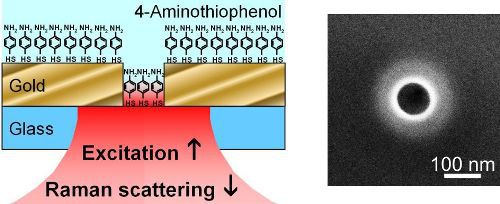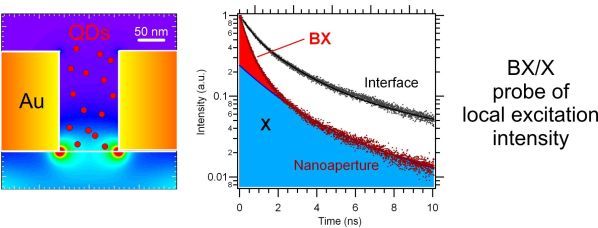Latest paper: single nanoaperture SERS
My team has released an article in the October 7th issue of the Journal of Physical Chemistry C.
A wide range of studies had been recently devoted to nanoaperture arrays as substrates to enhance the Raman scattering spectrocopy of adsorbed molecules. However, only partial information is known concerning the case of a single nanoaperture. Our paper fills this gap, and discusses the first quantitative evaluation of the SERS enhancement factors on single nanoapertures milled in optically thick gold films.
This work has three major aspects of interest to the SERS community:
1) Nanoapertures milled in noble metal films form interesting SERS substrates thanks to their rational and tunable design, controlled surface enhancement, and intrinsic robustness. We discuss the different design parameters yielding to optimum SERS enhancement already in a single aperture which can be used to further improve the SERS substrates with nanoaperture arrays.
2) We discuss different ways of expressing the SERS enhancement factor, and show excellent agreement between experimental results and numerical simulations.
3) Most experimental studies of controlled SERS substrates skip the issue of the adhesion layer between the gold nanostructure and the glass substrate. We experimentally demonstrate that the adhesion layer has a crucial effect on the SERS enhancement, and needs to be fully considered while designing nanosubstrates for high-sensitivity spectroscopy.
A reprint for personal use only is freely available here.

Next conference : EOS annual meeting 2010
Meet me at the TOM3 Nanophotonics and Metamaterials during the next annual meeting of the European Optical Society.
I'll have a talk on Thursday October 28th 10am. While most of the presentation should focus on our recent methods to experimentally characterize optical nano-antennas, I'll also show some of our most recent (unpublished) results on controling fluorescence directional emission.

Do you want to give a boost to your h index ?
With a title like this, I'm sure my blog will receive much visits from search engines ![]() . If you came here while looking for some h index or h factor data, then you'll already wasting your time.
. If you came here while looking for some h index or h factor data, then you'll already wasting your time.
Procrastinate a few more minutes to this very well written article (in French only sorry). For the English-reading only people, I've also selected this editorial. Be careful all this is highly ironic !
Latest paper published: Qdots on nanoantennas
Check out in the August issue of ACS Nano, a paper in collaboration with the Weizmann Institute of Science on the use of colloidal quantum dots to probe the local field enhancement on photonic antennas.
Plasmonic nanoantennas constitute a very active area of nanosciences, and have turned into essential devices to manipulate light at the nanoscale. Various spectroscopic methods are commonly used to quantify the overall amplification brought by an optical antenna on the emitted signal. However, experimentally characterizing the antenna’s response at the excitation frequency solely remains a scientific and technical challenge. Such characterization is highly needed to fully understand and optimize the antenna’s design.
Our paper describes a novel experimental method to directly characterize the antenna amplification on the excitation field independently on the emission process. We take advantage of the complex transient photoluminescence dynamics of colloidal quantum dots to probe photonic nanoantennas made of dielectric microspheres and gold nanoapertures.
This work has four major aspects of general interest:
1) we describe a novel and direct approach to quantify the electromagnetic amplification on an optical antenna for the excitation process only.
2) we demonstrate a new form of enhanced (nonlinear) light-matter interaction at the nanoscale via the increased doubly excited state formation on nanoantennas
3) we introduce a novel use of multiple excited states in colloidal quantum dots for nanophotonic applications. This effect is impossible to obtain with (organic) molecular systems.
4) we show excellent agreement between experimental results and numerical simulations.

Introducing Thibault Wenger--Lehnert
I'm very glad to announce the birth of my son Thibault on August 24th 2010. He's already a charming person.




